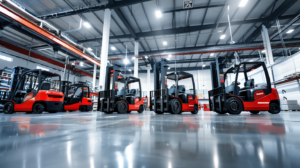Operating a forklift safely is critical to maintaining a secure and productive work environment. One of the key factors in ensuring forklift safety is controlling the speed at which these powerful machines operate. This article delves into the considerations for determining a safe speed for a forklift, including industry standards, the impact of the operating environment, and the importance of operator training.

Understanding Forklift Speed Regulations
Forklifts are essential tools in many industries, from warehousing to construction, but they also pose significant risks if not handled properly. According to the Occupational Safety and Health Administration (OSHA), the general rule is that forklifts should be operated at a speed that allows the operator to maintain full control at all times. However, OSHA does not specify an exact speed limit for forklifts. Instead, the appropriate speed is often determined by factors such as the environment, the type of load being carried, and the specific model of the forklift.
Factors Influencing Safe Forklift Speeds
While there is no universal speed limit, several factors influence what is considered a safe speed for a forklift:
- Work Environment: The type of surface the forklift is operating on significantly impacts safe speeds. For example, a forklift operating on smooth, flat surfaces may be able to travel faster than one on uneven or slippery surfaces. Additionally, forklifts operating in congested areas or near pedestrians should reduce their speed to avoid accidents.
- Load Type and Weight: The weight and size of the load a forklift is carrying can also determine its safe speed. Heavier loads may require slower speeds to maintain control and stability, especially when turning or maneuvering.
- Forklift Design and Model: Different forklift models have varying capabilities and limitations. Electric forklifts, for instance, may have different acceleration and braking characteristics compared to gas-powered models. The manufacturer’s recommendations for speed based on the model’s design should always be considered.
- Visibility and Lighting: Poor visibility due to lighting conditions or the load blocking the operator’s view can necessitate a reduction in speed. Operators should slow down in areas with poor lighting or where their visibility is compromised.
- Weather Conditions: External weather conditions can also affect forklift operation. Wet, icy, or snowy conditions can make surfaces slippery, requiring a significant reduction in speed to prevent accidents.
Recommended Speed Limits for Forklifts
While OSHA does not prescribe specific speed limits, many companies adopt their own standards based on best practices and industry recommendations. A commonly accepted guideline is that forklifts should not exceed a speed of 8 mph (about 12.8 km/h) in open areas and should slow down to 3 mph (about 4.8 km/h) when operating indoors or in areas with pedestrian traffic. However, these speeds can vary depending on the factors mentioned above.

The Role of Forklift Speed Governors
To enforce speed limits, many forklifts are equipped with speed governors. These devices limit the maximum speed at which a forklift can travel, ensuring that operators cannot exceed safe operating speeds. Speed governors are particularly useful in environments where maintaining a consistent speed is critical for safety.
Training and Education: Key to Safe Operation
One of the most crucial aspects of forklift safety is proper operator training. Even with speed governors in place, an operator’s understanding of how to safely control the forklift at various speeds is essential. Training programs should emphasize the importance of adjusting speed according to the environment and load conditions.
The Impact of Speed on Forklift Stability
Speed has a direct impact on a forklift’s stability. Forklifts have a higher center of gravity than most vehicles, making them more susceptible to tipping over, especially when carrying loads. Higher speeds increase the likelihood of tipping, particularly during turns or when navigating uneven surfaces. Ensuring that operators understand the relationship between speed and stability is critical to preventing accidents.
Best Practices for Maintaining Safe Speeds
To maintain safe forklift speeds, companies should implement the following best practices:
- Regular Speed Monitoring: Use technology such as speed monitoring systems or telematics to track forklift speeds and ensure compliance with safety guidelines.
- Clear Signage: Post speed limit signs in areas where forklifts operate, particularly in high-risk areas like intersections or where pedestrians are present.
- Routine Maintenance: Regularly maintain forklifts to ensure that speed governors and braking systems are functioning correctly. A well-maintained forklift is more likely to operate safely at recommended speeds.
- Conduct Risk Assessments: Regularly assess the work environment for any changes that might require adjustments to forklift speed limits. This includes changes in floor conditions, lighting, or the introduction of new hazards.
- Promote a Safety Culture: Encourage a workplace culture that prioritizes safety over speed. Operators should never feel pressured to exceed safe speeds to meet productivity goals.

Conclusion: Prioritizing Safety Over Speed
Determining a safe speed for a forklift is not a one-size-fits-all decision. It requires careful consideration of various factors, including the work environment, the type of load, and the specific forklift model in use. By adhering to industry best practices, conducting regular risk assessments, and ensuring that operators are well-trained, companies can significantly reduce the risk of accidents and ensure that their forklift operations are both safe and efficient.
While speed can enhance productivity, it should never come at the cost of safety. The key is to find a balance that allows forklifts to operate efficiently while minimizing the risk of accidents. By doing so, companies can protect their employees, equipment, and bottom line.




